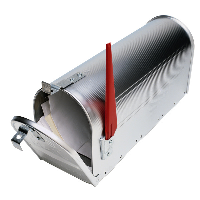Cheque’s In The Mail
By Dan Boudreau
The professionals who handle bankruptcies are among the busiest people in our part of the world. This is a sad reality. Financial trouble and bankruptcy visably turn a person’s life upside down. What is less obvious is when anyone suffers financial difficulty or bankruptcy, everyone is affected. Families, friends, employees and vendors – from the small garage down the street to the giant credit card companies, banks and tax collectors. The entire community is affected.
To those of us who operate small businesses, this means “credit with caution”. The easiest way to avoid risking bad debts is to stick to cash sales. Unfortunately, this is not always possible. Some types of business require that you take on the risk of extending credit to customers.
Our organization has been in the business of providing training now since 1987. Our training contracts typically range in value from as little as a couple hundred dollars to ten or twenty thousand. The nature of the training business is that we really need to trust that clients will pay in order to stay in business. Most of our clients insist that we provide the training and get paid afterwards. We used to provide all training first and invoice at the end of the training. This is the “play before pay” approach.
In the first ten years of business we never lost a dime due to bad debts, then things changed. During the latter half of the nineties we wrote off tens of thousands of dollars in bad debts. The first hit was when we lost about $8,000 to a not-for-profit organization. Over the next couple of years we managed to lose more than $10,000 to a three different entities. Apparently we were slow learners. We then took another hit by a client who simply refused to pay us for approximately $40,000 worth of work completed during 2001. We had seriously drifted from doing good business to too many dosages of bad business.
Although we were angry about being $60,000 short of where we should have been, we were too busy to spend much time stewing about the losses. We could spend more time pursuing the culprits, but we do not wish to spend a lot of time fighting legal battles, spending good money after bad. Ultimately those unpaid amounts will have far less affect on us than they will on those who don’t pay their bills. We’re focussed on building goodwill and not dwelling on the negative aspect of this challenge.
We are a little wiser and lot more wary these days. In the interest of staying in business, we have had to tighten our belts, our systems and our level of trust with certain clients. If you are in a business that requires you to take on the risk of extending credit in order to secure contracts, you may be interested in the following points.
1. Keep a classy client service attitude.
Use the 95/5 rule. Do not let the 5% who may default cause you to apply a poor client service attitude to the other 95%. You can probably trust 95% of your clients and it is important to manage those relationships with respect and trust. If you find that the negative 5% control your attitude, it’s probably time to get out of the business.
2. Rate your clients.
Any system can serve the purpose. Here is one way to do it:
* # 1 client – no risk – extend full credit
* # 2 client – low risk – extend limited credit
* # 3 client – high risk – pay before you play
* # 4 client – time waster – no play at any price
3. Do your research before extending credit to a client.
Get signed permission from the client to do a credit check on the client. Ask for credit references and check those references. Ask questions such as:
* “Do you extend credit to this person or business?”
* “Does the client pay you on time every time?”
* “How much time or effort do you have to invest to get paid by this client?”
Be aware that there are strict laws governing the sharing of information about clients. This tends to restrict people somewhat when it comes to providing negative information. You will need to listen attentively and read between the lines to get the real answers. Sometimes your real answers are embedded within a reference persons’ reluctance to answer questions.
4. Build in safety.
Take small risks with new or unknown clients. Determine a level of loss you can live with, extend that amount of credit to the client and observe how they manage it. Do they pay? If so, do they pay on time, every time? If they can’t pay, do they call you or do they wait for you to call them? Your gut will tell you whether to take more or less risk with the client.
5. Collect your receivables promptly.
Follow up quickly when a client defaults on a payable. Be fair but firm in your approach. Sometimes people and businesses just need a bit of room to work through tough times – sometimes they have no intention of paying you and use any extra time to get their friends paid ahead of you. The most important thing to learn about a client is whether they have integrity, whether or not they honour their word. When dealing with people who have integrity, you can afford to take a bit more risk.
6. Never enter a business deal without having an agreement signed by both parties.
Your agreement should clarify costs, deliverables and timelines. Clear communication pays dividends when it comes to satisfying clients. Although a verbal agreement is apparently legally binding, you and I probably don’t want to have to spend the money necessary to prove what you said, they said and vice versa. A signed agreement will lend a lot of credibility to your case if you end up having to use the legal system to collect your money.
7. Those who default on paying their bills will create bad press for you.
Bad press creates the opposite of goodwill. In all cases where clients have defaulted they immediately began slandering our organization. These comments range from libelous personal attacks to well placed scud-like complaints calculated to devalue the service we provided and did not get paid for. It’s like a juvenile attempt to make themselves look better somehow by making us look bad. This would be troubling were it not so transparently pathetic. Yes, we could sue for liable, but when we’re in our lawyer’s office, he’s making money and we’re not. So far our strategy has been to stick to the high road and keep building goodwill.
8. Fortress.
Everything we do to strengthen our team is what I call fortressing. Once you have done all the work to find a number-one client and build a trusting relationship with them, treat them like the pure gold stars they are.
9. Keep records.
This pertains to all records leading up to and during your client transactions. But specifically, keep a record of clients who do not pay and communicate that information to your team and your friends. Those you tell are less likely to fall prey to that individual or business again.
10. Build goodwill.Good businesses succeed because they create value for their customers. The most important thing you can do in the face of bad debts is to continue to serve your best customers in the very best way you can. Never compromise your level of service to paying customers. Give each customer the best value possible with every engagement.
As stated earlier, the best way to avoid bad debt is to insist on cash sales only. If your business drags you kicking and screaming into the role of creditor, keep your head up.
It will take a cauldron of caution, a ton of trust and a pound of patience. If you tread down the play now pay later path, you too will inevitably one day hear that dreaded expression, cheque’s in the mail. If you’re careful there can be life after debt.
You are welcome to publish this article providing you attach this statement with the link back to the RiskBuster website:
“Dan Boudreau is President and CEO of Macrolink Action Plans Inc. and the RiskBuster Business Plan Oasis at http://www.riskbuster.com Writing your own business plan can be easy, fast and fun! Instantly download a free copy of Dan’s popular fast-track business plan template, The Shell, when you subscribe to the RiskBuster Oasis Insider at http://www.riskbuster.com” End

